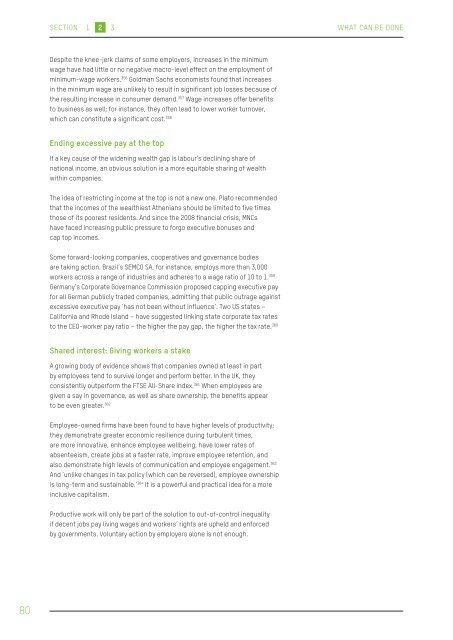1FW2e8F
1FW2e8F
1FW2e8F
Create successful ePaper yourself
Turn your PDF publications into a flip-book with our unique Google optimized e-Paper software.
SECTION 1 2 3<br />
WHAT CAN BE DONE<br />
Despite the knee-jerk claims of some employers, increases in the minimum<br />
wage have had little or no negative macro-level effect on the employment of<br />
minimum-wage workers. 356 Goldman Sachs economists found that increases<br />
in the minimum wage are unlikely to result in significant job losses because of<br />
the resulting increase in consumer demand. 357 Wage increases offer benefits<br />
to business as well; for instance, they often lead to lower worker turnover,<br />
which can constitute a significant cost. 358<br />
Ending excessive pay at the top<br />
If a key cause of the widening wealth gap is labour’s declining share of<br />
national income, an obvious solution is a more equitable sharing of wealth<br />
within companies.<br />
The idea of restricting income at the top is not a new one. Plato recommended<br />
that the incomes of the wealthiest Athenians should be limited to five times<br />
those of its poorest residents. And since the 2008 financial crisis, MNCs<br />
have faced increasing public pressure to forgo executive bonuses and<br />
cap top incomes.<br />
Some forward-looking companies, cooperatives and governance bodies<br />
are taking action. Brazil’s SEMCO SA, for instance, employs more than 3,000<br />
workers across a range of industries and adheres to a wage ratio of 10 to 1. 359<br />
Germany’s Corporate Governance Commission proposed capping executive pay<br />
for all German publicly traded companies, admitting that public outrage against<br />
excessive executive pay ‘has not been without influence’. Two US states –<br />
California and Rhode Island – have suggested linking state corporate tax rates<br />
to the CEO-worker pay ratio – the higher the pay gap, the higher the tax rate. 360<br />
Shared interest: Giving workers a stake<br />
A growing body of evidence shows that companies owned at least in part<br />
by employees tend to survive longer and perform better. In the UK, they<br />
consistently outperform the FTSE All-Share index. 361 When employees are<br />
given a say in governance, as well as share ownership, the benefits appear<br />
to be even greater. 362<br />
Employee-owned firms have been found to have higher levels of productivity;<br />
they demonstrate greater economic resilience during turbulent times,<br />
are more innovative, enhance employee wellbeing, have lower rates of<br />
absenteeism, create jobs at a faster rate, improve employee retention, and<br />
also demonstrate high levels of communication and employee engagement. 363<br />
And ‘unlike changes in tax policy (which can be reversed), employee ownership<br />
is long-term and sustainable.’ 364 It is a powerful and practical idea for a more<br />
inclusive capitalism.<br />
Productive work will only be part of the solution to out-of-control inequality<br />
if decent jobs pay living wages and workers’ rights are upheld and enforced<br />
by governments. Voluntary action by employers alone is not enough.<br />
80


